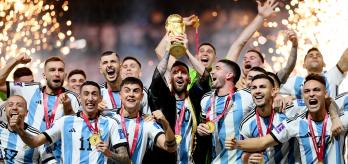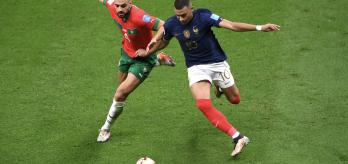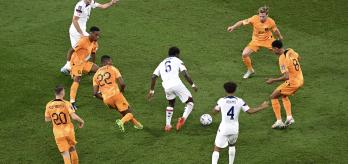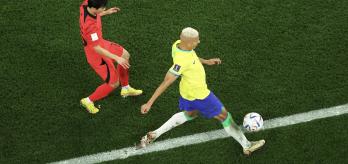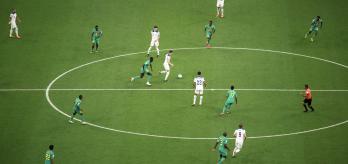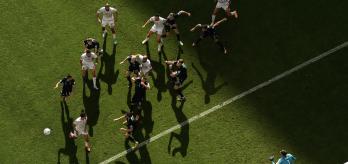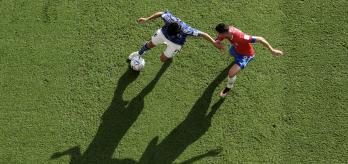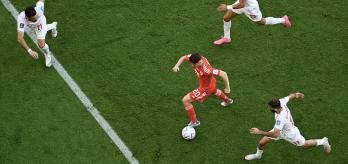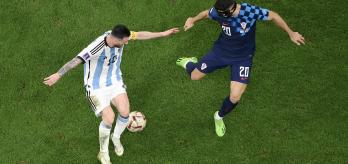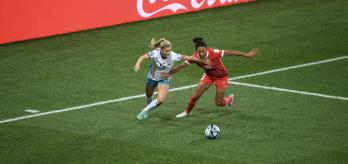Key points
-
Data reveals that central and defensive midfielders covered the most total distance and that centre-backs covered the lowest total distance in the FIFA World Cup Qatar 2022™.
-
Players in wide positions, such as wide midfielders and forwards, covered more distance at the higher intensities compared to players in central positions, such as centre-backs and midfielders.
-
Quadrant plots highlight that various positions occupy specific quadrants but large variations are present across each position.
Benchmarking specialised positions
A consistent finding in football science literature is that the physical demands of players are highly dependent upon their unique position in the team1. Most studies use broad categories to define roles such as defenders, midfielders and forwards or even distinct sub-categories within them (e.g. midfielders can be split into central and wide midfielders)2. However, this FIFA World Cup Qatar 2022™ physical analysis is the first to separate international players into eight highly specialised outfield positions:
- Centre-back (CB)
- Full-back/wing-back (FB/WB)
- Defensive midfielder (DM)
- Central midfielder (CM)
- Attacking midfielder (AM)
- Wide midfielder (WM)
- Wide forward (WF)
- Centre forward (CF)
Please note that the data provider assigned each of the positions and not the author.
Central midfielders versus centre-backs
Practitioners can use the data presented in Figures 1-3 to effectively benchmark each tactical role from a physical perspective. Figure 1 shows that central and defensive midfielders covered the most total distance and that centre-backs covered the lowest total distance in the FIFA World Cup Qatar 2022. Midfielders are renowned for their all-round industrious and versatile nature, and as such they covered the most ground during World Cup games as they were active during both in- and out-of-possession phases of play. To add context, Croatia's Brozović and Tunisia's Skhiri illustrate that some midfielders covered in excess of 13km during World Cup games (Figure 1).
In contrast, centre-backs are primarily active only during out-of-possession phases, hence the lower total distance covered. However, due to the ever-changing demands placed on international centre-backs, they increasingly receive the ball from their goalkeeper to play out from the back or from midfielders to (re)start build-up play3.
Adding further context, the opposition's quality and work rate can also have an impact on a centre-back's activity profile. For instance, Wales defender Mepham covered the greatest total distance for this position in the whole tournament (Figure 1). This performance was against the USA and can probably be attributed to the USA's extreme work rate alongside their frequent progressions and final-third entries during this game. In contrast, Brazilian centre-back Silva covered the lowest total distance for this position against Switzerland. Despite similar work-rate profiles between teams, this may have been due to Brazil's attacking dominance throughout the match and the lack of threat from Switzerland, resulting in this sedate work-rate profile for Silva.
Wide versus central positions
Figures 2 and 3 illustrate the distances that were covered at higher intensities (>20km/h and >25km/h) across various positions in the FIFA World Cup Qatar 2022. Players in wide positions, such as wide midfielders and forwards, clearly covered more distance at the higher intensities compared to players in central positions, such as centre-backs and midfielders. Numerous reasons can be attributed to this finding, ranging from superior physical characteristics for wide versus central players, in addition to the extra space in which wide players can operate along the flanks to accelerate up to higher speeds2. For instance, wide midfielders in the FIFA World Cup Qatar 2022 offered greater defensive and attacking balance as well as width, allowing for more high-intensity running to occur along the flanks.
In contrast, centre-backs and midfielders operate in central pitch regions that are highly dense with players, which limits their ability to accelerate into space at higher speeds. Figure 4 supports this assertation as the top ten fastest sprints in the World Cup were in excess of 35km/h and were primarily by players in wide positions. This visual also highlights the match-to-match variation of top speed for some of the fastest players in the tournament. The case studies presented in the "why" section will also add more detail as they will view the physical demands of each position through a tactical lens.
POSITION QUADRANT ANALYSIS OF VOLUME VERSUS EXPLOSIVENESS
The quadrant plots in Figures 5-7 compare the specialist defensive, midfield and attacking positions against one another to add even more insights.
Defenders
Figure 5 demonstrates that centre-backs primarily occupy the lower-left quadrant and that they generally cover low total and high-intensity game distances (low volume and low explosiveness). However, some large individual variations exist in the physical profiles for this position (e.g. Van Dijk v. Gvardiol). Full-backs/ wing-backs mainly occupy the lower- and upper-left quadrants, signifying that this position typically covers low total distances, but high-intensity distances can vary from high to low (low volume but varied explosiveness). Once again, individual players highlighted distinctly different physical profiles for this position (e.g. Robinson v. Hernandez v. Hakimi).
Midfielders
Defensive midfielders are split between the upper- and lower-right quadrants, highlighting that they cover considerable distances in total, but high-intensity distances can vary somewhat (high volume but varied explosiveness). Two world-class defensive midfielders are highlighted to add further context (e.g. Amrabat v. Casemiro). Figure 6 visualises the specialist midfield positions, with central midfielders mainly occupying the upper- and lower-right quadrants (high volume, varied explosiveness).
This is exemplified by box-to-box midfielders like England's Bellingham, who covered sizeable amounts of total and high-intensity distances, in contrast to the lower physical outputs of Croatia's Modrić, Argentina's Mac Allister or Belgium's Witsel. Wide midfielders mainly occupy the upper-right quadrant, exhibiting both volume and explosive characteristics, although large individual variation exists between players like Belgium's Castagne and Argentina's Di María. Attacking midfielders do not occupy any specific quadrant and are the most variable position from a physical perspective, with individual examples in completely different quadrants (e.g. Son v. Griezmann).
Forwards
Figure 7 illustrates the specialist forward positions and highlights that the majority of wide and centre forwards have either a low overall work rate and/or are more explosive and thus fall within all quadrants except the lower-right quadrant. England's Kane and Serbia's Milinković-Savić were the exception to this rule as they covered substantial total distance but lower high-intensity distance in these games. Interestingly, three of the greatest modern-day forwards fall within the lower-left quadrant, which means low in overall volume and explosiveness (Messi, Mbappé and Lewandowski).
This potentially indicates that these forwards have superior game intelligence and thus are extremely selective about when they exert themselves at higher intensities during games to maintain their technical and tactical sharpness. Moreover, given the major role that each plays for their team, they are also given more freedom to play and physically exert themselves accordingly. The tactical reasons for "why" these positions produce physical efforts will be explored in a later section of this analysis.
References
-
Ade J, Fitzpatrick J, Bradley PS. High-intensity efforts in elite soccer matches and associated movement patterns, technical skills and tactical actions. Information for position-specific training drills. Journal of Sports Sciences. 2016, 34: 2205-2214.
-
Bradley PS, Sheldon W, Wooster B, Olsen P, Boanas P, Krustrup P. High-intensity running in English FA Premier League soccer matches. Journal of Sports Sciences. 2009, 27:159-168.
-
Bradley PS. The Premier League Way: Contextualising the Demands of the World's Most Intense League. 2022, Amazon, UK.

